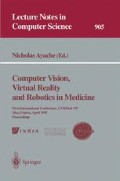Abstract
This paper presents computer vision based techniques for object registration, real-time tracking, and image overlay. The capability can be used to superimpose registered images such as those from CT or MRI onto a video image of a patient’s body. Real-time object registration enables an image to be overlaid consistently onto objects even while the object or the viewer is moving. The video image of a patient’s body is used as input for object registration. Reliable real-time object registration at frame rate (30 Hz) is realized by a combination of techniques, including template matching based feature detection, feature correspondence by geometric constraints, and pose calculation of objects from feature positions in the image. Two types of image overlay systems are presented. The first one registers objects in the image and projects preoperative model data onto a raw camera image. The other computes the position of image overlay directly from 2D feature positions without any prior models. With the techniques developed in this paper, interactive video, which transmits images of a patient to the expert and sends them back with some image overlay, can be realized.
Access this chapter
Tax calculation will be finalised at checkout
Purchases are for personal use only
Preview
Unable to display preview. Download preview PDF.
References
E.R. John, L.S. Prichep, J. Fridman and P. Easton, Neurometrics: computer-assisted differential diagnosis of brain disfunction, Science Vol. 239, pp. 162–169 (1988).
L.S. Hibbard, J.S. McGlone, D.W. Davis, R.A. Hawkins, Three-Dimensional Representation and Analysis of Brain Energy Metabolism, Science, Vol. 236, pp. 1641–1646 (1987).
C. Nastar and N. Ayache, Non-Rigid Analysis in Medical Images: a Physically Based Approach, Proc. 13th Int. Conf. on Information Processing in Medical Imaging, Berlin, Germany, pp. 17–32 (1993).
W.E.L. Grimson, T. Lozano-Perez, W.M. Wells, G.J. Ettinger, S.J. White, R. Kikinis, An Automatic Registration Method for Frameless Stereotaxy, Image Guided Surgery, and Enhanced Reality Visualization, Proc. CVPR’94, pp. 430–436, Seattle, WA (1994).
C. Pelizzari, K. Tan, D. Levin, G. Chen, J. Baiter, Interactive 3D Patient–Image Registration, Proc. 13th Int. Conf. on Information Processing in Medical Imaging, Berlin, Germany, pp. 132–141 (1993).
D. Gennery, Tracking known three-dimensional objects, Proc. 2nd Nation. Conf. Artif. Intell., Pittsburgh, pp. 13–17 (1982).
D.G. Lowe, Robust Model-Based Motion Tracking Through the Integration of Search and Estimation, Int. J. Computer Vision, Vol. 8, No. 2, pp. 113–122 (1992).
D.G. Lowe, Fitting Parameterized Three-Dimensional Models to Images, IEEE Trans. Patt. Anal. Mach. Intell. Vol. 13, No. 5, pp. 441–450 (1991).
D.B. Gennery, Visual Tracking of Known Three-Dimensional Objects, Int. J. Computer Vision, Vol. 7, No. 3, pp. 243–270 (1992).
M. Turk and A. Pentland, Face Recognition Using Eigenfaces, Proc. CVPR’91, pp.586–591, Maui, U.S.A. (1991).
H. Murase and S. Nayar, Parametric Eigenspace Representation for Visual Learning and Recognition, Tech. Rep. CUCS-054–92, Columbia University, NY (1992).
S. Yoshimura and T. Kanade, Fast Template Matching Based on the Normalized Correlation by Using Multiresolution Eigenimages, Proc. IROS’94, Munchen, Germany (1994).
O. Amidi, Y. Mesaki, T. Kanade, and M. Uenohara, Research on an Autonomous Vision-Guided Helicopter, Proc. RI/SME Fifth World Conf. on Robotics Research, Cambridge, Massachusetts (1994).
I. Weiss, Geometric Invariants and Object Recognition, Int. J. Computer Vision, Vol. 10, No. 3, pp. 207–231 (1993).
J. Munday and A. Zisserman, Introduction-Towards a New Framework for Vision. In Geometric Invariance in Machine Vision, MIT Press, Cambridge, MA (1992).
H. F. Dunant-Whyte, Uncertain Geometry in Robotics, IEEE J Robotics and Automation, Vol. 4, No. 1, pp. 23–31 (1988).
Author information
Authors and Affiliations
Editor information
Editors and Affiliations
Rights and permissions
Copyright information
© 1995 Springer-Verlag Berlin Heidelberg
About this paper
Cite this paper
Uenohara, M., Kanade, T. (1995). Vision-Based Object Registration for Real-Time Image Overlay. In: Ayache, N. (eds) Computer Vision, Virtual Reality and Robotics in Medicine. CVRMed 1995. Lecture Notes in Computer Science, vol 905. Springer, Berlin, Heidelberg. https://doi.org/10.1007/978-3-540-49197-2_2
Download citation
DOI: https://doi.org/10.1007/978-3-540-49197-2_2
Publisher Name: Springer, Berlin, Heidelberg
Print ISBN: 978-3-540-59120-7
Online ISBN: 978-3-540-49197-2
eBook Packages: Springer Book Archive

